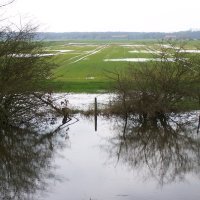 Bildrechte: B. Königstedt
Bildrechte: B. KönigstedtThe Elbe Marshes
The part of the Elbe valley lowlands now protected by dykes from the river floods is known locally as the ‘marsh’. These areas are mainly put to agricultural use, with about equal proportions of arable land and pastures. An intricate drainage system provides for the necessary regulation of the waterways. Many of today’s ditches and channels trace the previous course of the Elbe. Of the arable crops, grains predominate, followed by rape and maize. The meadowland of the marsh consists mainly of intensively used grassland with a narrow range of species present. However, there are also large expanses of mesophilic grassland with oat-grass meadows (Arrhenatherion elatoris) and white clover - rye-grass meadows (Lolio – Cynosuretum) which attract a greater variety of species.
During the winter period, the Elbe Marsh becomes the stage for the spectacular sight of huge flocks of migrant birds from the north. Around 50% of the approximately 140,000 bean geese (Anser fabalis)and greater white-fronted geese (Anser albifrons) which are regularly counted as visitors to Lower Saxony choose to spend the winter in the Elbe valley. The exact figures can vary greatly from year to year and indeed within the wintering period. The birds take advantage of the food supplies available in the extensive grasslands, winter rape and winter grain fields. Contractual arrangements with the affected farmers provide for the necessary compensation to allow agriculture and nature conservation, i.e. man and nature, to coexist in harmony.
Farming on the eastern bank of the Elbe tends to be on a larger scale than on the western part of the biosphere reserve. This goes back to the days of the German Democratic Republic, in which agriculture was organized on the basis of large communal farming units. The landscape is diversified by large solitary oaks, avenues of trees, hedges and small groups of trees and shrubs. Small pockets of deciduous woods bear witness to the large oak, elm and ash woods which used to exist as characteristic features of the marshland flora. Examples of such woods are the Vitico near Bleckede, the Parens and the Bohldamm in Amt Neuhaus as well as the Elbholz in the Elbe marshes of Gartow.
The endangered insect known as the great Capricorn beetle (Cerambyx cerdo), which can reach 5 cm in length, has been found on the edges of the Elbholz and in nearby rows of oaks and also in solitary trees. In the past, this beetle could be found throughout Germany, but now there are only two places in Lower Saxony where it is known to exist, one of which is the Elbe valley. Together with the hermit beetle, an up to 4 cm long relative of the rose chafer (Cetoniidae), this beetle represents one of the indicator species for the biosphere reserve. It lives in seclusion in the humus-like material which collects in the holes often to be found in old deciduous trees.
 Bildrechte: B. Königstedt
Bildrechte: B. KönigstedtElbe marsh near Gartow



 deutsch
deutsch english
english